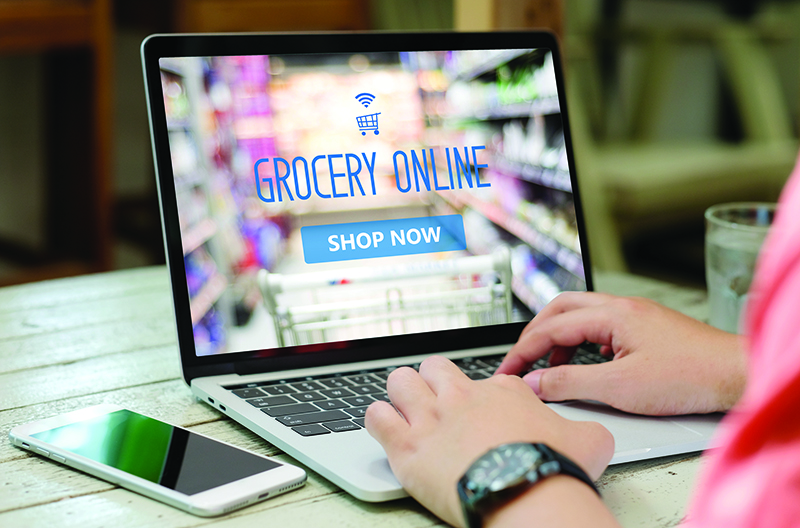In late September, Instacart launched its initial public offering. The e-commerce company offers online ordering fulfillment, plus an online marketplace for retailers. (We have many IGA stores as Instacart partners.)
Their IPO offers a lot of insights into the e-commerce market in the U.S., starting with its value. During COVID-19, when shoppers were forced out of restaurants and many were afraid to shop, the company’s valuation was rumored to be $39 billion. It launched at a value of about $10 billion.
Many industry experts predicted the end of physical shopping when the internet launched. They predicted it again during COVID. And certainly, when looking at strong retail brands that once ruled and have faded (such as Bed Bath & Beyond), all blaming e-commerce and Amazon for their demise, we can see how industry observers would think that brick-and-mortar retailers will fade away.
We didn’t see that in the U.S. Certainly, some shoppers came online during COVID, and many have stayed there. And many new, younger shoppers are choosing e-commerce as their preferred way of shopping.
But the core grocery shopper in the U.S. stayed in-store. And they continue to do so for many categories. Last year, about 11 percent of U.S. grocery sales were online. And unlike the 30 percent or more market share predicted just a few years ago, e-commerce grocery share is expected to grow more moderately – up to 13.6 percent in the next three years.
Now 13 percent of an $850 billion dollar industry is still big dollars. But it isn’t the market share growth so many experts foresaw. It is worth looking into why growth is slower than anyone thought.
Many of IGA’s international markets have had significantly greater e-commerce market share, especially in Asia, with China, Malaysia, Singapore. And in many international countries, e-commerce share is growing at double the U.S. rates.
Why is the U.S. lagging in e-commerce? And what about U.S. grocery markets is blunting accelerated e-commerce growth?
First, the cost of labor. Fulfillment and delivery are a much greater percentage of cost of total service here than in many international markets.
Second, technology adoption rates for basically everything are often higher internationally than in the U.S. The World Bank does a digital adoption rate index for countries. Many Americans might be surprised that, as a percentage of income, we as a country often are behind many countries worldwide.
But I have a different opinion. E-commerce has lagged here because, by and large, the experience is highly undifferentiated. We can put a hand over the retailers’ logo and have no idea with whom we are shopping. Shopping online commoditizes food in a way that none of us should celebrate.
When our assortment gets squished into little boxes and rectangles, shopping for groceries online is just a fulfillment mechanic. No wonder replenishment items like razor blades and pet food were some of the first categories to take off online.
All the things that make independent grocers special – amazing fresh produce, incredible meat departments, cool items in the deli and locally grown/raised/sourced items – become one of thousands of choices, all curated and contained in rectangles on a website or phone.
For our retailers using Instacart, their collected traffic has helped bring new shoppers to IGA. But in another way, their growth hasn’t helped us. When shoppers come into a retailer through their marketplace, we are just one of many choices for shoppers to order food. That further diminishes unique selling advantages and further commoditizes the products we sell.
Which of course, is the exact opposite of what shoppers want. Food is an exciting, fun category. Consumers want to know more about food: how it was made, what ingredients it uses, where it was sourced and how it will taste. Food products and categories rank amongst Google’s highest ranked searches.
The U.S. grocery market is still in the early days of figuring out how to win online. The next phase will see retailers investing in content to differentiate products. We will see user reviews, integrated nutrition and recipe content and significantly better branding.
And, of course, we will see data come alive to make shopping easier for consumers. Look for customized sorting based on a shopper’s previous shopping experience, including ad hoc categorization based on shopper interests (gluten-free, sugar-free, non-GMO, etc.).
And look for AI-based recommendation engines that suggest add-ons determined from a shopper’s previous interests. These could include built-in pop-up wine or beer pairings, recommended side dishes based on favorite recipes and integrated solution matrices (take 20 percent of the calories out of that favorite meatloaf) for goals shoppers set as their own personal shopping mission.
The good news for brick-and-mortar retailers is the things that make us cool are still valued by consumers. The challenge is to figure out the digital equivalent for those advantages. For example, what is the digital equivalent of amazing customer service, product insights and know-how, as well as connection to local suppliers?
If we want online to be a key piece of the value proposition, we must infuse it with brand DNA. Only then will we see the kinds of breakout growth that other industries have experienced online.
Read more association news from The Shelby Report.

